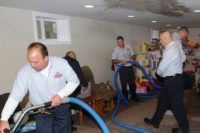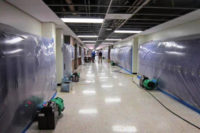NHRA Pro Stock class is one of the most tightly competitive in all of motor racing. Cagnazzi Racing consistently keeps its cars at the top of the class by gathering and analyzing a wealth of information. But there's always a need for more.

Everett, Wash. -- NHRA (National Hot Rod Association) Pro Stock class is one of the most tightly competitive in all of motor racing. Cagnazzi Racing consistently keeps its cars - the JEGS.com Chevy Cobalt driven by five-time champion and 2008 series winner Jeg Coughlin, and the Charter Communications/LifeLock Chevy Cobalt driven by Dave Connolly - at the top of the class. The 2009 race season starts Feb. 5 in Pomona, Calif.
The cars, powered by 500-cubic-inch V-8 engines, are equipped with 64 sensors that gather data on everything from coolant temperature, manifold pressure and fuel flow to clutch action, wheel speed, engine speed, acceleration and suspension movement.
Together this wealth of data helps Cagnazzi Crew Chief Roy Simmons analyze exactly what takes place in every second of every run. But there’s always a need for more. That’s what first drew Simmons to the Fluke Ti25 thermal imager.
Fluke Corporation knows a lot about high performance. So the match was perfect when Cagnazzi Racing, the 2007 and 2008 champs in NHRA Pro Stock racing, chose the Fluke Ti25 Thermal Imager to seek that winning split second advantage.
Simmons first tried the Fluke Ti25 at the NHRA Supernationals at Englishtown, N.J., searching the track for hot spots. “I didn’t use it to change my routine,” he said, “but I started finding out that it did verify what we were experiencing on the race track. With the Ti25, what we thought we were seeing, we could see.”
Fluke Thermal imagers detect infrared (heat) radiation and create images that show temperature variations within the target area. Fluke 3D-IR technology shows temperature variances in three-dimensional form that makes hot spots and other potential problem areas really stand out.
Drag strip temperatures can hit 140 °F on a hot day, Simmons said, making tires lose traction. Temperatures too cool can also cause problems. The strip at Denver features a starting area chilled by coolant piped under the surface. Simmons used the Fluke Ti25 to spot the borders of the cooler area, so he could set the cars up to avoid making the critical shift to second gear as they crossed the transition zone.
He also used the thermal imager to check the car itself. When he checked the tires after a run, the Fluke Ti25 showed that the big drag slicks heat up not at the center, where you might expect, but at the outside corners. Even towing the car a mile to an inspection area warmed the tires by 12 °F. You could learn as much with a temperature probe, he said, but an actual picture is a lot better than a list of readings.
Simmons said he anticipates using the Fluke Ti25 to check exhaust manifolds for hot spots caused by restricted flow, to check for weak valve springs and more.
“In the past, you’d kind of rub your foot on the ground and say ‘this is what I think is happening, so this is what I’ll do,’” Simmons said. “Nobody before has been able to say ‘I know for a fact that this is what it looks like, this is where the hot spots are in the tire, in the race track and the other components on the car.’”
“What it has done is exactly what you want to do in racing,” Simmons said about the Fluke Ti25. “What this does is start the conversation, and the process moves into going faster. The thermal imager is saying ‘this is what it is,’” Simmons said. “Is that good or bad? That’s for you to decide. Anything that gives you information and makes your brain work is a great tool.”


